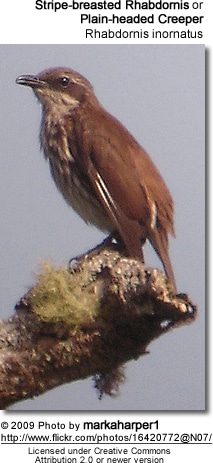Philippine Creepers or rhabdornise
The Philippine creepers or rhabdornise are small passerine birds.
Distribution / Range
The family is endemic to the Philippines. The group contains a single genus Rhabdornis with three species. They do not migrate, other than local movements.
Description
Philippine creepers are 6 to 7 inches (15 to 17 centimeters) long and weigh between 3 and 4 ounces (80 to 95 grams).
The Philippine creepers are similar in appearance to treecreepers (Certhiidae).
As a group, Philippine creepers are very similar in size and color. However, there is little known about the specific details of the family’s size and color. Philippine creepers are marked and shaded with black, brown, red-brown, gray, and white; colors that help them to blend into the forests in which they live. The birds have dark brown streaks on their upperparts, white on the underparts and flanks (with blackish streaks), and lighter streaks on the other parts of their body.
Their behaviour is said to resemble that of tits, to which they are not related, more than the treecreepers. Nests are tree crevices

Diet / Feeding
Philippine creepers run across the tops of tree branches, hop and jump between branches on trees, and crawl on tree bark found on the trunks and main limbs of trees during their foraging for food within the forest.
They search on the bark of tree trunks and branches and even among flowers. Philippine creepers eat mostly insects, but also nectar (sweet liquid produced by flowering plants), fruits, and seeds.
Their long, slender bill allows them to easily remove insects from bark, while their brush-tipped tongue enables them to quickly feed on nectar.
Species
- Stripe-headed Creeper, Rhabdornis mysticalis
- Long-billed Creeper, Rhabdornis grandis
- Plain-headed Creeper, Rhabdornis inornatus
There are two other small bird families with ‘treecreeper’ or ‘creeper’ in their name: Australian treecreepers, and treecreepers. The latter are discussed above, the former are an entirely unrelated family of passerine birds.
Taxonomy
The placement of the genus Rhabdornis in a family of its own (Rhabdornithidae Greenway, 1967) is not accepted by all authorities, and it is sometimes placed in Certhiidae or Timaliidae. The German name, Trugbaumläufer (“false treecreepers”), reflects this uncertainty. More recently, Zuccon et al. 2006 placed them in a basal clade inside the starlings in the family Sturnidae. Their closest allies seem to be a number of quite plesiomorphic starling lineages mainly from the Asian-Pacific region (such as mynas), so this placement seems as plausible as any other. Judging from biogeography alone, the treecreepers are indeed far less likely to be related to the Philippine creepers than starlings or timaliids, as neither the Certhiidae nor their close relatives expanded into the Wallacea whereas the latter did. Note also the general rarity of small woodpeckers o the Philippines, implying that any bird lineage that would happen to adapt to the same ecological niche was likely to be successful.
Nonetheless, the placement with the starlings requires confirmation. As notoriously confounded by convergent evolution as Philippine creeper anatomy is, the scenario of Zuccon et al. requires the underlying plesiomorphies closer to those present in starlings and thrashers than to those retained in treecreepers and wrens, and vice versa as regards synapomorphies. This has not been tested; in the meantime, it may be noted that the color pattern of Rhabdornis is more similar to that of some Aplonis – a member of the group of starlings supposedly most close to the Philippine creepers – than to that of treecreepers. Both Philippines and treecreepers are cryptic in adaptation to their tree-creeping lifestyle, but this is achieved with a very different camouflage pattern in either. Additionally, they are very distant even among starlings (Zuccon et al. 2006: 340) and may in the end be maintained as a family on their own.




